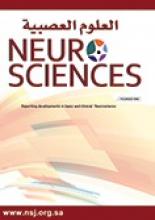Abstract
OBJECTIVE: The incidence of stroke and the demand for rehabilitation services continues to increase. Risk factors may act as stroke outcome predictors and hence determine the type and intensity of rehabilitation. Our aim is to investigate stroke outcome predictors that will define groups with maximal or minimal benefit from rehabilitation after stroke.
METHODS: Our longitudinal prospective study included 111 ischemic stroke patients, admitted consecutively to the Rehabilitation Department, Hamad Medical Corporation, Qatar, during 2000-2001. We analyzed the influence of modifiable risk factors: diabetes mellitus (DM), hypertension (HTN), ischemic heart disease (IHD) and non-modifiable factors: age, gender, race and side of lesion on stroke outcome. All patients received regular rehabilitation and underwent an evaluation on admission and discharge, using the Modified Barthel Index.
RESULTS: Statistical analysis demonstrated that the group of patients with IHD showed greatest improvement after 3 months of rehabilitation. The group without co-morbidities followed this, and then the HTN, DM, combined DM and HTN and combined HTN and IHD groups. The group that suffered from combined DM, HTN, and IHD did not show improvement. Non-modifiable risk factors showed no significant differences. However, younger patients showed a tendency for better improvement.
CONCLUSION: Those patients with modifiable risk factors had significant impact on rehabilitation outcome (p-value = 0.009). Those with one or 2 co-morbidities had the highest score of improvement after rehabilitation while the group of patients with more than 2 co-morbidities did not show improvement. However, non-modifiable risk factors did not play a significant role in stroke outcome.
- Copyright: © Neurosciences
Neurosciences is an Open Access journal and articles published are distributed under the terms of the Creative Commons Attribution-NonCommercial License (CC BY-NC). Readers may copy, distribute, and display the work for non-commercial purposes with the proper citation of the original work.






